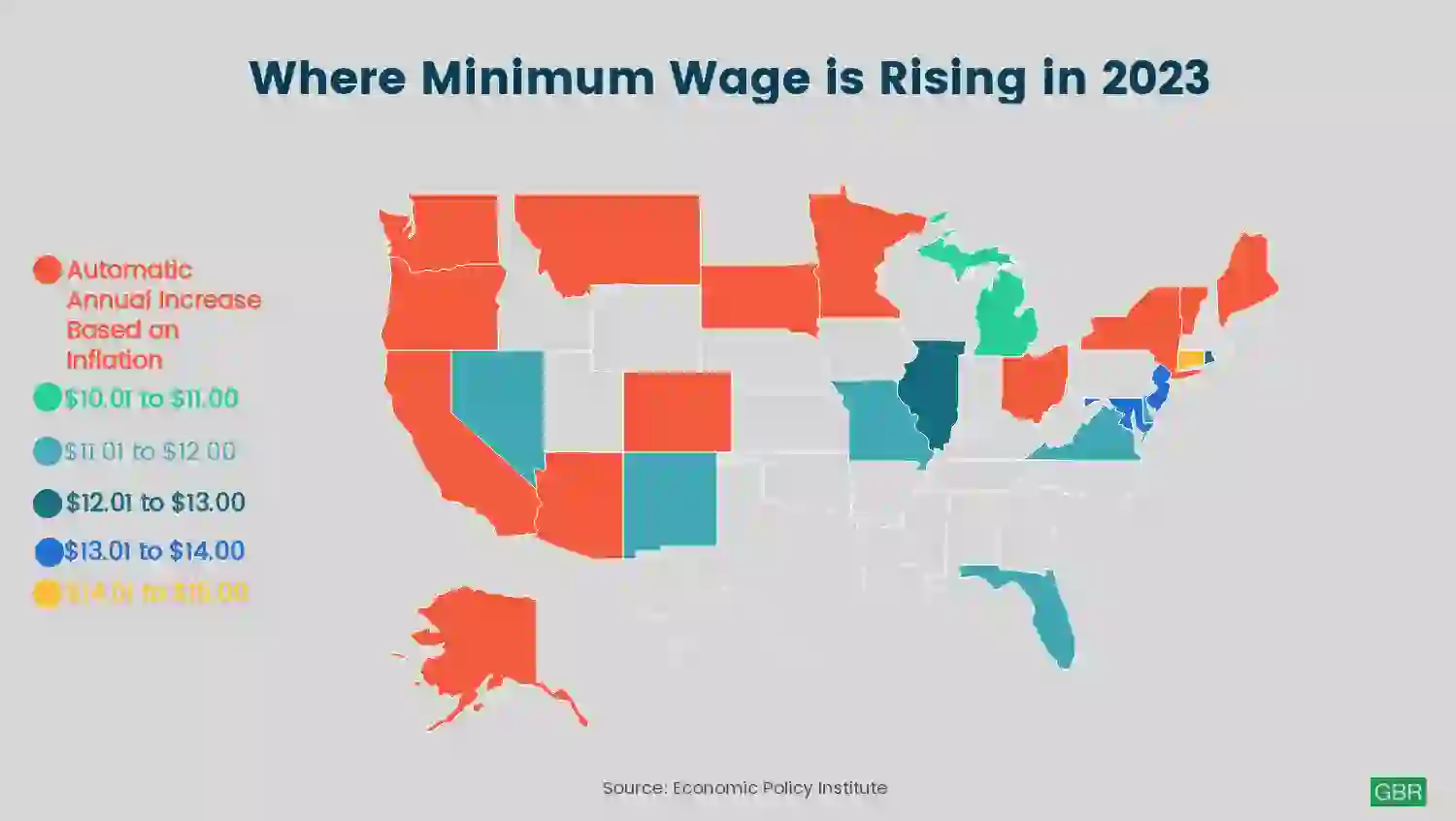How Much These 12 States Will Increase Their Minimum Wage By in 2023

Commitment to Our Readers
GOBankingRates' editorial team is committed to bringing you unbiased reviews and information. We use data-driven methodologies to evaluate financial products and services - our reviews and ratings are not influenced by advertisers. You can read more about our editorial guidelines and our products and services review methodology.

20 Years
Helping You Live Richer

Reviewed
by Experts

Trusted by
Millions of Readers
The federal minimum wage has been $7.25 an hour since 2009. That was 13 years ago. That’s the longest the minimum wage has remained stagnant since the Fair Labor Standards Act first set it at 25 cents an hour in 1938.
An adult working full-time at the federal minimum wage earns $58 for an eight-hour workday. That’s $290 for a 40-hour workweek, or about $1,160 per month — before taxes.
The cumulative rate of inflation has increased by 38.1% since 2009. That same worker would need $10.01 in 2022 money to buy something that cost $7.25 in 2009. What their weekly $290 could buy in 2009 now costs $400.35. They would need $1,601.39 to buy what their monthly $1,160 could buy when the current minimum wage last moved during the Great Recession.
Thanks to the relentless gnawing of inflation, what was already a poverty wage in 2009 is now a starvation wage.
In response to the federal government’s 13-year run of indifference, many states have taken action to increase their own minimum pay thresholds to something approaching a living wage.

In 20 States, the Bottom Is Still $7.25
According to the Economic Policy Institute, 30 of America’s 50 states and Washington, D.C., have enacted minimum wages that are higher than the federal standard. That leaves 20 where employers are still allowed to pay their workers as little as $7.25 an hour. Five of them — Alabama, Louisiana, Mississippi, South Carolina and Tennessee — have no minimum wage at all. Two others — Georgia and Wyoming — still have their minimum wages set at $5.15 an hour. In all seven of those states, the federal threshold of $7.25 applies.
The other 13 states that default to the federal standard of $7.25 are:
- Idaho
- Indiana
- Iowa
- Kansas
- Kentucky
- New Hampshire
- North Carolina
- North Dakota
- Oklahoma
- Pennsylvania
- Texas
- Utah
- Wisconsin
18 States and D.C. Use Common Sense: Indexing for Inflation
Of the 30 states plus D.C. that have minimum wages higher than the federal standard, 18 of them work on a system that seems like a no-brainer — automatically raising the minimum wage incrementally as inflation reduces the dollar’s buying power. Among them is Washington, D.C., which boasts the highest minimum wage in America at $16.10 an hour.
Here’s a look at the states with automatic increases and their current minimum wages:
- Alaska: $10.34
- Arizona: $12.80
- Colorado: $12.56
- Connecticut: $14
- Florida: $10
- Maine: $12.75
- Minnesota: $10.33
- Missouri: $11.15
- Montana: $9.20
- Nevada: $10.50
- New Jersey: $13
- New York: $13.20
- Ohio: $9.30
- Oregon: $13.50
- South Dakota: $9.95
- Vermont: $12.55
- Virginia: $11
- Washington: $14.49
12 State Legislatures Approved Raises for Their Workers in 2023
In 2023, 12 states will boost their minimum wages due to scheduled legislative action, regardless of whether they index for inflation or not. Here they are in ascending order from the lowest upcoming minimum wage to the highest:
- Michigan: The minimum wage will increase from its current $9.87 to $10.10 on Jan. 1, 2023.
- Nevada: The minimum wage will increase from its current $10.50 to $11.25 on Jan. 1, 2023.
- Delaware: The minimum wage will increase from its current $10.50 to $11.75 on Jan. 1, 2023.
- Florida: The minimum wage will increase from its current $11 to $12 on Sept. 30, 2023.
- Missouri: The minimum wage will increase from its current $11.15 to $12 on Jan. 1, 2023.
- New Mexico: The minimum wage will increase from its current $11.50 to $12 on Jan. 1, 2023.
- Virginia: The minimum wage will increase from its current $11 to $12 on Jan. 1, 2023.
- Illinois: The minimum wage will increase from its current $12 to $13 on Jan. 1, 2023.
- Rhode Island: The minimum wage will increase from its current $12.25 to $13 on Jan. 1, 2023.
- Maryland: The minimum wage will increase from its current $12.50 to $13.25 on Jan. 1, 2023.
- New Jersey: The minimum wage will increase from its current $13 to $14 on Jan. 1, 2023.
- Connecticut: The minimum wage will increase from its current $14 to $15 on Jan. 1, 2023.
 Written by
Written by  Edited by
Edited by 

























